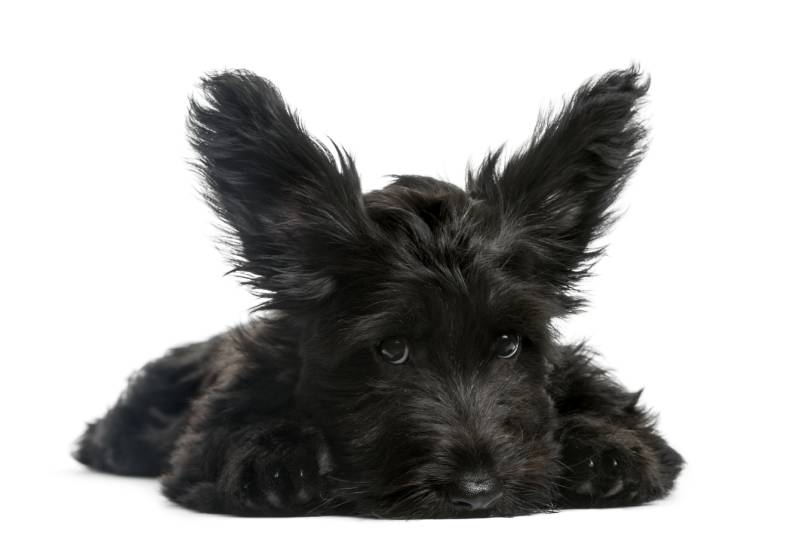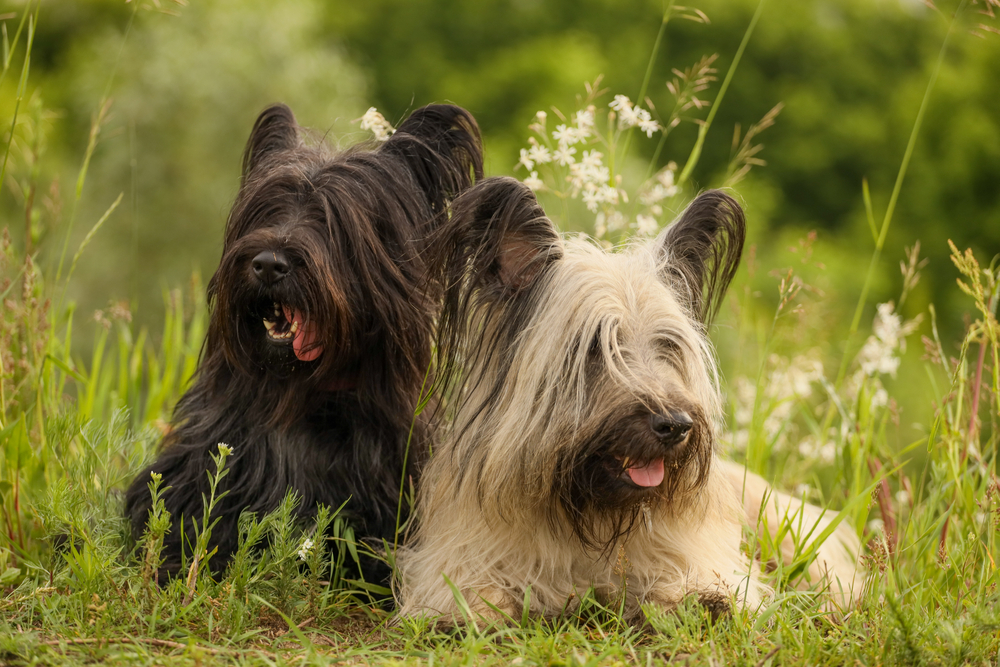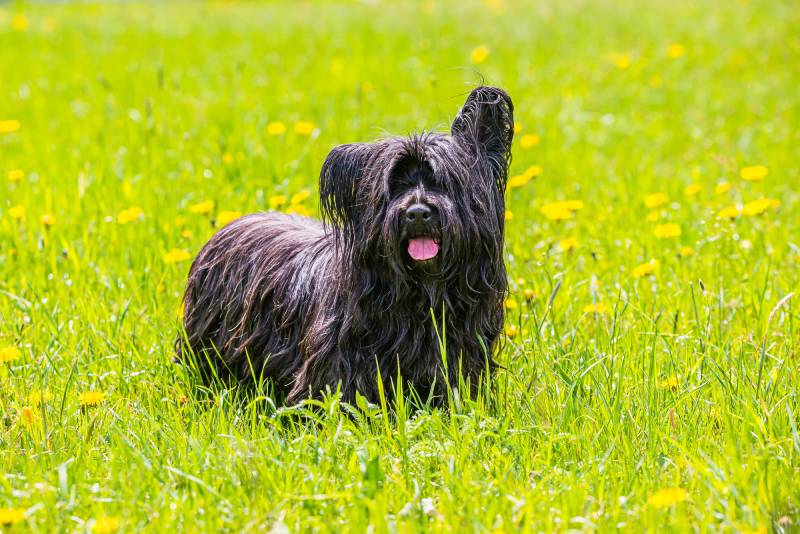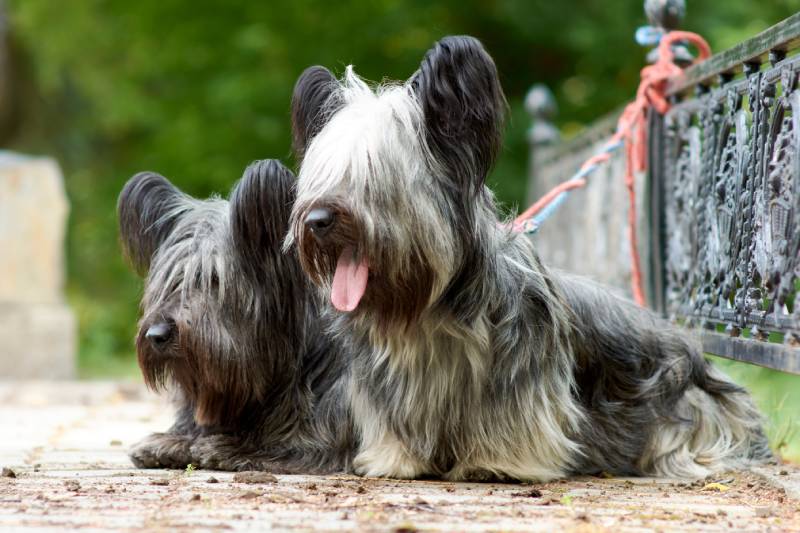In this article
View 8 More +Developed on the Isle of Skye in Scotland, the Skye Terrier is a formidable hunting dog that was bred to hunt farm vermin like badgers, otters, and foxes. Like other terriers, they’re brave, willful, and completely without shyness or timidness.
Now, Skye Terriers are kept as companions and show dogs. They get along with people well, even if it takes a minute to assess them and develop strong attachments to their owners. Skyes are also adaptable, working well on both farms and in apartments with the right care.
However, there are some important considerations for a Skye Terrier, including their need to be around their owners, their intolerance for rowdy children, and more. Here’s everything you need to know about the Skye Terrier.
Breed Overview
Height:
9–10 inches
Weight:
25–40 pounds
Lifespan:
12–15 years
Colors:
Black, blue, cream, fawn, gray, platinum, silver
Suitable for:
Families with older children, multi-dog households, attentive owners
Temperament:
Smart, loyal, energetic, vocal, reserved with strangers
Skye Terriers have been around for at least four centuries. While many terrier breeds acquired their current appearance in the last century, the Skye Terrier has more or less looked the same. We just may not have known their name. Over time, the Skye Terrier has been known as the Clydesdale Terrier, Fancy Skye Terrier, Silky Skye Terrier, Glasgow Terrier, and Paisley Terrier.
Skye Terrier Characteristics

Skye Terrier Puppies

Skye Terriers are among the most endangered native dog breeds in the UK. There are only between 3,000 and 4,000 remaining in the world, so it may be a challenge to find a breeder with an available litter. You may need to get on wait lists until a puppy is available to purchase.
That said, there are a few breed-specific rescue organizations for Skye Terriers. These dogs may be given up for a variety of reasons, including nuisance barking, poor socialization, chasing animals, or simply because owners no longer have time for them.
Skye Terrier Origin & History
Skye Terriers were found in the Isle of Skye in Scotland, leading to their name. Several breeds have gone by the name “Skye Terrier,” however, which makes it challenging to trace their history. They were bred to hunt badger, fox, and otter, with a long and low body to follow small game into burrows.
In fact, these loyal dogs were said to be under the petticoat of Mary, Queen of Scots, at her execution. Queen Victoria also contributed to the breed, developing both drop-eared and prick-eared dogs.
In 1881, Vero Shaw’s “The Illustrated Book of the Dog” was published with a lithography of Skye Terriers, boosting their popularity. The dogs were brought to America and officially recognized by the American Kennel Club in 1887. They began to appear in shows, but they’ve since declined as people sought out other terrier breeds.

Temperament & Intelligence of the Skye Terrier
Skye Terriers are centuries-old, intelligent, and strong-willed dogs. Like other terriers, they are tenacious in the face of an adversary and don’t tolerate nonsense from adults, kids, or other animals. However, they are calmer than other terrier breeds. With the right training and respect, they can be sweet, polite, and affectionate.

Are These Dogs Good for Families?👪
Skye Terriers are generally agreeable dogs, but they may prefer gentle and quiet children. They are patient and tolerant, but it’s important not to allow rough play that can injure a small breed. Never leave a Skye with children unsupervised. It’s best to monitor interactions until children are older and know how to interact with the Skye carefully.
Does This Breed Get Along With Other Pets?🐶 😽
Skye Terriers may get along with other dogs if they’re socialized properly. However, they may be reserved at first. Being a terrier breed, Skyes should not be trusted with cats or small pets, including rabbits, hamsters, rats, birds, and reptiles. Their high prey drive will undoubtedly encourage them to chase small animals.

Things to Know When Owning a Skye Terrier
If you want to welcome a Skye Terrier into your family, here’s everything you need to know about the breed and their care:
Food & Diet Requirements🦴
Skye Terriers need a high-quality diet that meets their diet and exercise requirements. They have long, low bodies, so it’s crucial that they’re not overfed. An overweight Skye is not only at risk for a variety of health problems, but carrying extra pounds can cause devastating joint or back injuries in dogs with this build. If you have any concerns about your Skye’s body condition or diet, consult with your vet.

Exercise🐕
The Skye is a hunting dog that likes a job to do, but they don’t need a ton of exercise. Short walks outside and play time in the yard can be enough to keep the Skye happy and avoid boredom. These dogs don’t have the build, energy, or endurance for long hikes or jogs, however, so it’s best to keep sessions short.
Training🎾
Skye Terriers are easy to train because of their intelligence. They can be willful and don’t respond to harsh training methods. They may hold a grudge. Rely on positive reinforcement techniques like praise and treats. It’s vital to be consistent and patient when training the Skye. Early socialization is also important to ensure that your Skye isn’t reactive to new people, places, and things.

Grooming✂️
Though they may look high maintenance, Skye Terriers don’t require a lot of upkeep. Regular combing a few times a week is enough to remove tangles and loose hair to keep their coat and skin healthy. Occasional baths should be fine to keep the Skye Terrier clean unless you’re playing outside in mud and dirt. Pay close attention to the eyes and mouth, which may build up grime more easily.
Health and Conditions🏥
Skye Terriers have long bodies with short legs, which can contribute to different types of health problems. Degenerative disc disease is a common problem with Skyes and other short-legged dogs, as well as conditions like hyperthyroidism, autoimmune diseases, and hemangiosarcoma, an aggressive type of cancer.
- Hyperthyroidism
- Arthritis
- Parasites
- Cancer
- Autoimmune disease
- Degenerative disc disease
Male vs Female
There’s little difference between male and female Skye Terriers. They’re close in height and weight and similar in temperament, especially if they’re spayed or neutered. Fixing your dog is recommended to prevent reproductive health problems, such as mammary cancer, that is common in female Skyes. It can also prevent some behaviors related to sex hormones, such as roaming.

3 Little-Known Facts About the Skye Terrier
1. Skye Terriers Are Scotland’s Most Devoted Dogs.
In the 1850s, a night watchman in Edinburgh, John Gray, adopted a Skye Terrier to keep him company on his nightly walks. When he passed away, the dog, Bobby, refused to leave his grave. The graveyard keeper eventually made a shelter for Bobby, and the dog continued to visit for 14 years. Once Bobby passed away, a statue of him was erected near the graveyard.
2. Skye Terriers Were Essential for Royalty.
Queen Victoria was fond of Skye Terriers, increasing their popularity as a status symbol. During the Victorian era, nobility wouldn’t be seen in the park without a Skye Terrier at their side.
3. Skye Terriers Were Initially Bred for Work.
Like other terriers, Skyes were created as working dogs and showed bravery and toughness. They were developed to protect farms from nuisance animals like foxes, badgers, otters, and other pests. This is part of the reason for their long coats, which make them appear much larger and more threatening.

Final Thoughts
Skye Terriers make great pets, even for novice owners. While some terriers will quickly become the boss if they have a timid owner, Skyes are generally agreeable and aim to please (with a touch of stubbornness). However, Skye Terriers can be difficult to find and don’t tolerate rough treatment, either from owners or young children, and they need to be with an owner who won’t leave them alone for long periods.
Featured Image Credit: Lourdes Photography, Shutterstock



















